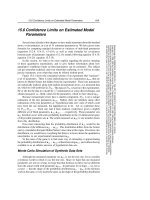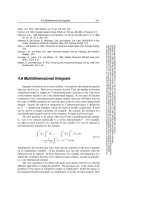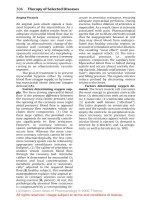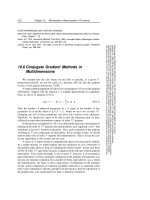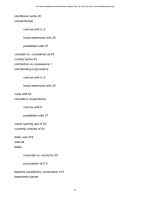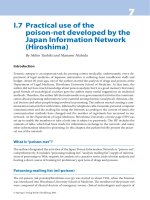AN ATLAS OF DEPRESSION - PART 7 pptx
Bạn đang xem bản rút gọn của tài liệu. Xem và tải ngay bản đầy đủ của tài liệu tại đây (1.58 MB, 11 trang )
Figure 4.5 Flow chart illustrating the use of the DSM-IV criteria for the diagnosis of affective disorders with a seasonal pattern specifier
DSM-IV diagnostic criteria met for diagnosis of affective disorders
with a seasonal pattern specifier
DSM-IV diagnostic
criteria not met for
diagnosis of affective
disorders with a seasonal
pattern specifier
Ye s
Ye s
Ye s
Ye s
No
No
No
No
Has the patient had a regular temporal relationship between the onset of
their major depressive episode(s) in bipolar I and bipolar II disorder or
major depressive disorder, recurrent and a particular time of the episode
(e.g. regular appearance of the major depressive episode in the fall or winter*)?
A
Does the patient undergo full remission (or a change from depression to mania
or hypomania) at a characteristic time of year (e.g. depression disappears in spring)?
B
In the last 2 years, has the patient had two major depressive episodes that
demonstrate the temporal seasonal relationships defined in A and B, and no
non-seasonal major depressive episodes have occurred during the same period?
C
Have the seasonal major depressive episodes (as described above) outnumbered
the non-seasonal major depressive episodes that may have occurred over the
patient's lifetime?
D
* Cases in which there is an obvious effect of season-related psychosocial stressors (e.g. regularly being unemployed each winter)
should not be included
©2002 CRC Press LLC
Figure 4.7 The causes of mania-like episodes
Figure 4.6 Graph showing the ten leading causes of worldwide disability. Data from Murray CJL, Lopez AD, eds. The Global Burden of
Disease: a Comprehensive Assessment of Mortality and Disability from Diseases, Injuries, and Risk Factors in 1990 and Projected to 2020. Boston:
Harvard University Press, 1996
Millions of people living with disability
Unipolar major depression
Iron deficiency anemia
Falls
Alcohol use
Chronic obstructive pulmonary disease
Bipolar disorder
Congenital anomalies
Osteoarthritis
Schizophrenia
Obsessive–compulsive disorders
10
20 30 40 50 600
Antidepressant
treatment (anti-
depressant drugs,
electroconvulsive
therapy and
light therapy)
Acute
schizoprenic
episodes
Manic
episodes
Non-prescribed
psychoactive
substances,
e.g. amphetamines,
cocaine and
caffeine
Various
unassociated
medical conditions,
e.g. hyper-
parathyroidism
Prescribed
medication
Possible
causes of
mania-like
episodes
©2002 CRC Press LLC
Figure 4.8 Flow chart illustrating the use of DSM-IV criteria for the diagnosis of mania
DSM-IV criteria met for diagnosis of mania
DSM-IV criteria not
met for diagnosis of
mania –
alternative diagnosis
needed
No
No
No
Ye s
Ye s
Ye s
No
Ye s
No
Do the symptoms meet the criteria for a 'mixed' episode?
1 Inflated self-esteem or grandiosity (which may be delusional)
2 Decreased need for sleep (e.g. feels rested after only 3 hours’ sleep)
3 Increased talkativeness or pressure of speech
4 Flight of ideas or racing thoughts
5 Distractibility (attention easily drawn to unimportant or irrelevant external stimuli)
6 Increase in goal-directed activity (socially, at work or school, or sexually) or
psychomotor agitation
7 Excessive involvement in pleasurable activities that have a high potential for painful
consequences
Has the patient had three or more of the following symptoms persisting (four if the
mood is only irritable) and have these symptoms been present to a significant degree?
Has the patient had a distinct period of abnormally and persistently elevated, expansive
or irritable mood lasting at least 1 week (or any duration if hospitalization is necessary)?
A
B
C
Is the patient's mood disturbance sufficiently severe to cause a marked impairment
in occupational or social function, relationships with others or to necessitate
hospitalization to prevent harm to others, or are there psychotic features?
D
Ye s
Are the patient's symptoms due to the direct physiologic effects of a substance
(e.g. drug of abuse, medication or other treatment) or a general medical condition
(e.g. hyperthyroidism)?
E
©2002 CRC Press LLC
Figure 4.10 The psychologic responses to loss
Figure 4.9 The physical symptoms of normal grief
Aches and pains
(e.g. headaches,
musculoskeletal
pain, tightness in
chest and throat)
Fatigue
Changes in
sleep pattern
Appetite changes
(usually anorexia with
weight loss)
Gastrointestinal changes
(nausea, vomiting,
indigestion, constipation
and diarrhea)
Reduced immunologic
response and increased
incidence of infections,
such as colds and sore
throats
Depression
Anxiety
Hypervigilance
Anger
Guilt
Loneliness
Lack of concentration
and attention (memory
loss for specific events)
Preoccupation (repetitive
thoughts about the
deceased)
Helplessness/hopelessness
Feeling of detachment/
distance
Sense of unreality
Psychologic responses to loss
Emotional
Cognitive Behavioral
Irritability (anger and
hostility, suspiciousness,
distrust)
Restlessness
Searching
Crying
Social withdrawl
©2002 CRC Press LLC
Figure 5.2 The physiologic response to ‘flight or fight’ stimuli
General unspecific
Metabolism: glucose mobilized
Immune system suppressed
Brain
Mental activity increases
Eyes
Pupils dilate
Ciliary muscle relaxed (for far sightedness)
Mouth
Saliva production stops
Heart
Heart output increases
Blood pressure rises
Under arms
Sweat glands: increase secretion
Apocrine glands: increase seretion
Gastrointestinal
Digestion shuts down
Bladder
Bladder sphincters
contract
Skin
Blood flow to skin increases
Blood coagulation increases
Kidneys
Kidneys decrease output
Muscles
Blood vessels mostly constrict,
except to some muscles
Muscle: increased strength
Lungs
Breathing increases
Airways dilate
Figure 5.1 Comorbidity of ICD-10 anxiety and depressive disorders. Reproduced with permission from Sartorius N, Üstün TB,
Lecrubier Y,Wittchen HU. Depression comorbid with anxiety:results from the WHO study on psychological disorders in primary health
care. Br J Psychiatry 1996;suppl 30:38-43
©2002 CRC Press LLC
Figure 5.3 Flow chart describing the use of DSM-IV criteria for the diagnosis of generalized anxiety disorder
DSM-IV criteria met for diagnosis of generalized anxiety disorder
DSM-IV criteria not
met for diagnosis of
generalized anxiety
disorder
Ye s
No
No
No
No
No
Ye s
Ye s
No
Ye s
Is the disturbance due to the direct physiologic effects of a substance (e.g. a
drug of abuse or a prescribed medication or a general medical condition
(e.g. hyperthyroidism) and does not occur exclusively during a mood disorder,
psychotic disorder or pervasive developmental disorder?
1 Restlessness or feeling keyed up or on edge
2 Being easily fatigued
3 Difficulty concentrating or mind going blank
4 Irritability
5 Muscle tension
6 Sleep disturbance
Is the focus of the anxiety and worry not confined to features of an Axis I disorder –
e.g. the anxiety or worry is not about having a panic attack (as in panic disorder),
being embarrassed in public (as in social phobia), being contaminated (as in obsessive–
compulsive disorder), being away from home or close relatives (as in separation anxiety
disorder), gaining weight (as in anorexia nervosa), having multiple physical complaints
(as in somatization disorder) or having a serious illness (as in hypochondriasis) and the
anxiety and worry do not occur exclusively during post-traumatic stress disorder?
Has the patient experienced excessive anxiety and worry (apprehensive expectation),
occurring more days than not for at least 6 months, about a number of events
or activities (such as work or school performance)?
A
D
H
Do the patient's anxiety, worry or physical symptoms cause clinically significant
distress or impairment in social, occupational or other important areas of functioning?
E
Ye s
Are the patients's anxiety and worry associated with at least three of the following
six symptoms (with at least some of the symptoms present for more days than not
in the last 6 months)? NB Only one item is required in diagnoses of overanxious
disorder of childhood.
C
B
Does the patient find it difficult to control their worry ?
Ye s
©2002 CRC Press LLC
Figure 5.5 The symptoms of panic. Compare with Figure 5.2
Figure 5.4 Lifetime rates of panic disorder. Data from Weissman MM, Bland RC, Canino
GJ, et al. The cross-national epidemiology of panic disorder. Arch Gen Psychiatry
1997;54:305–9
3.0
2.5
2.0
1.5
10
0.5
0.0
Lifetime rates (%)
USA (ECA)
Canada
Puerto Rico
France
Germany
Italy
Lebanon
Taiwan
Korea
New Zealand
Fear of dying
Fear of losing control
Fear of collapse
Fear of going mad
Depersonalization/
derealization
Choking
Shortness of breath
Palpitations
Chills/hot flushes
Sweating
Pins and needles
Dizziness
Pallor
Chest pain
Butterflies/nausea
Urge to defecate
Trembling
©2002 CRC Press LLC
Figure 5.6 Flow chart describing the use of the DSM-IV criteria for the diagnosis of panic disorder with agoraphobia
Criteria met for diagnosis of panic disorder with agoraphobia
Criteria not met
for diagnosis of
panic disorder
with agoraphobia
Ye s
No
No
Ye s
Ye s
Ye s
No
Ye s
No
Are the patient's panic attacks due to the direct physiologic effects of a
substance (e.g. a drug of abuse or a prescribed medication) or a general medical
condition (e.g. hyperthyroidism)?
1 Persistent concern about having additional panic attacks
2 Worry about the implications of the attack or its consequences (e.g. losing control,
having a heart attack, 'going crazy')
3 A significant change in behavior related to their attacks
Does the patient have the presence of at least one the following?
Does the patient have recurrent unexpected panic attacks?
Does the patient have agoraphobia?
A
B
D
C
No
Are the panic attacks better accounted for by another mental disorder – such as
social phobia (e.g. occurring on exposure to feared social situations), specific phobia
(e.g. on exposure to a specific phobic situation), obsessive–compulsive disorder (e.g. on
exposure to dirt in someone with an obsession about comtamination), post-traumatic stress
disorder (e.g. in response to a stimulus associated with a severe stressor) or separation
anxiety disorder (e.g. in response to being away from home or close relatives)?
E
©2002 CRC Press LLC
Figure 5.7 Flow chart describing the DSM-IV criteria for the diagnosis of social phobia
A marked and persistent fear of one or more social or performance situations in which the
person is exposed to unfamiliar people or to possible scrutiny by others. The individual fears
that he or she will act in a way (or show anxiety symptoms) that will be humiliating or
embarrassing. Note: in children, there must be evidence of the capacity for age-appropriate
social relationships with familiar people and the anxiety must occur in peer settings,
not just in interactions with adults
A
The fear or avoidance is not due to the direct physiological effects of a substance (e.g. a drug
of abuse, a medication) or a general medical condition and is not better accounted for by
another mental disorder (e.g. panic disorder with or without agoraphobia, separation anxiety
disorder, body dysmorphic disorder, a pervasive developmental disorder, or schizoid
personality disorder)
G
Exposure to the feared social situations almost invariably provokes anxiety, which may take
the form of a situationally bound or situationally predisposed panic attack. Note: in children,
the anxiety may be expressed by crying, tantrums, freezing, or shrinking from social situations
with unfamiliar people
B
The avoidance, anxious anticipation, or distress in the feared social or performance situation(s)
interferes significantly with the person's normal routine, occupational (academic) functioning,
or social activities or relationships, or there is marked distress about having the phobia
E
If a general medical condition or another mental disorder is present, the fear in criterion A
is unrelated to it (e.g. the fear is not of stuttering, trembling in Parkinson's disease, or
exhibiting abnormal eating behavior in anorexia nervosa or bulimia nervosa)
H
The person recognizes that the fear is excessive or unreasonable. Note: in children, this feature
may be absent
C
In individuals under age 18 years, the duration is at least 6 months
Social phobia
F
The feared social or performance situations are avoided or else are endured with intense
anxiety or distress
D
Specify if the social phobia is generalized: if the fears include most social situations (e.g. initiating or
maintaining conversations, participating in small groups, dating, speaking to authority figures,
attending parties) Note: Also consider the additional diagnosis of avoidant personality disorder.
©2002 CRC Press LLC
Figure 5.9 [Above and right] Flow chart illustrating the use of the DSM-IV criteria for the diagnosis of post-traumatic stress disorder
Ye s
No
No
Ye s
No
No
1 Recurrent and intrusive distressing recollections of the event, including images,
thoughts and perceptions. Note: in young children repetitive play may occur in
which themes or aspects of the trauma are expressed
2 Recurrent distressing dreams of the event. Note: in children there may be
frightening dreams without recognizable content
3 Acting or feeling as if the traumatic event were recurring (includes a sense of
reliving the experience, illusions, hallucinations and dissociative flashback episodes,
including those that occur on awakening or when intoxicated). Note: in young
children trauma-specific re-enactment may occur
4 Intense psychologic distress at exposure to internal or external cues that
symbolize or resemble an aspect of the traumatic event
5 Physiologic reactivity on exposure to internal and external cues that symbolize
or resemble an aspect of the traumatic event
Has the patient been exposed to a traumatic event?
A
Ye s
Did the patient experience, witness or be confronted by an event or events that
involved actual or threatened death or serious injury, or a threat to the physical
integrity of themselves or others?
B
Ye s
Does the patient persistently re-experience the traumatic event in at least one
of the following ways?
D
C
Did the patient's response involve fear, helplessness or horror?
Note: in children, this may instead be expressed by disorganized or agitated behavior.
Figure 5.8 Age of onset of social phobia. Most cases of social
phobia start before the age of 20 years. Reproduced and adapted
with permission from Schneier FR, Johnson J, Hornig CD, Liebowitz
MR,Weissman MM. Social phobia. Comorbidity and morbidity in an
epidemiologic sample. Arch Gen Psychiatry 1992;49:282–8
30
20
10
Age at onset (years)
0
%
0–5
6–10
11–15
16–20
21–25
26–30
31–35
36–40
41–45
46–50
51–55
61–65
71–75
66–70
56–60
©2002 CRC Press LLC
No
Is the duration of the patient's disturbance (symptoms in D, E and F) more than
1 month?
G
Ye s
1 Difficulty falling or staying asleep
2 Irritability or outbursts of anger
3 Difficulty concentrating
4 Hypervigilance
5 Exaggerated startle response
Does the patient have persistent symptoms of increased arousal that was not
present before the trauma, as indicated by at least two of the following?
F
Ye s
Does the disturbance cause clinically significant distress or impairment in social,
occupational or other important areas of functioning?
H
Ye s
Specify: ACUTE if duration of symptoms is less than 3 months, CHRONIC if
duration of symptoms is 3 months or more, DELAYED ONSET if onset of
symptoms occurs at least 6 months after the stressor
Diagnosis of post-traumatic stress disorder
Criteria not met
for diagnosis of
post-traumatic
stress disorder
No
No
No
Ye s
1 Efforts to avoid thoughts, feelings or conversations associated with the trauma
2 Efforts to avoid activities, places or people that arouse recollections of the trauma
3 Inability to recall an important aspect of the trauma
4 Markedly diminished interest or participation in significant activities
5 Feeling of detachment or estrangement from others
6 Restricted range of affect (i.e. unable to have loving feelings)
7 Sense of foreshortened future (e.g. does not expect to have a career, marriage,
children or a normal lifespan)
Does the patient persistently avoid the stimuli associated with the trauma and is
there a numbing of general responsiveness (which was not present before the
trauma), as indicated by at least three of the following:
E
©2002 CRC Press LLC
